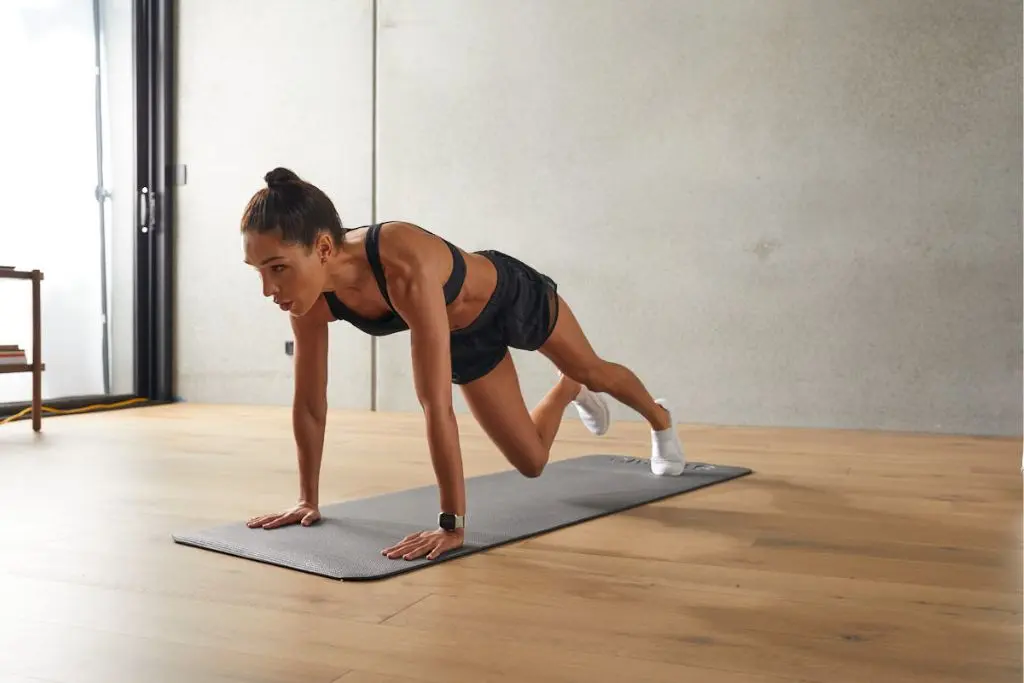What Is Tabata And How Will It Transform Your Workouts?

March 31, 2021

Twenty seconds is nothing, right? But if you’re familiar with Tabata workouts, you’ll be well aware those 20 seconds can feel like an eternity.
For those yet to make friends (or enemies) with Tabata training, then get ready to welcome it into your workout schedule with open arms for a fast, challenging and effective way to boost your fitness.
If you’re a HIIT lover or trying to get fit in a flash, Tabata has the power to change the way you train, and features in many Sweat programs such as FIERCE, FIERCE Zero Equipment, High Intensity Strength, Elite Conditioning, Energising HIIT and Low Impact HIIT.
What is Tabata?
Tabata is a style of high-intensity interval training (HIIT) that involves 20 seconds of exercise at your maximum effort, followed by 10 seconds of rest, for a certain number of rounds. It was founded by Japanese scientist Izumi Tabata, who studied the effects of moderate vs high-intensity training in the late ‘90s.
Both groups exercised five days a week for six weeks, but one group trained for an hour at a moderate intensity, while the other trained at a high intensity for just four minutes, alternating between 20 seconds of maximum effort and 10 seconds of rest.
Tabata and his fellow researchers found that HIIT training can be an effective way to improve anaerobic and aerobic systems significantly, whereas moderate-intensity exercise only improves your aerobic fitness.
Ana-what? Compared to aerobic exercise, where your body has a continuous supply of oxygen (think power walking, jogging or swimming), anaerobic exercise is when you’re moving in short, intense bursts and your body relies on energy stored in your muscles (think powerlifting or sprints). Anaerobic exercise feels much harder!
With Tabata, your body is forced to use both systems at once as you alternate between hard work and rest. This means you can improve your fitness in a shorter amount of time. Gotta love that!
Don’t be fooled into thinking that working in 20-second bursts will be easy. If you’re doing it properly and working at your max, it will be tough and you’ll be puffing and gritting your teeth to the very end, but you’ll feel like a warrior when you’re done!

How long is a Tabata workout?
Although traditionally structured as a four-minute workout with eight rounds of the 20-seconds-on, 10-seconds-off structure (this is still definitely a great place to start and enough to feel the burn), many modern Tabata workouts are much longer in duration or follow a 40-seconds-on, 20-seconds-off structure.
If you’re truly working at your max, you shouldn’t be able to go for much longer (if at all!) than 40 seconds as your muscles will start to fatigue, you’ll be out of breath or you’ll start to compromise on your form. Good form and maximum effort is the goal here!
The number of rounds and the exercises themselves can all be modified to suit different fitness levels, which is why Tabata makes a great high-intensity training option for so many people.
Tabata exercises: What's involved?
Tabata is more about the time structure and the intensity than specific movements, which means your workouts could involve a huge variety of exercises!
For example, one of the full-body Tabata workouts in Chontel Duncan’s FIERCE program features eight different exercises including jump squats, push-ups, burpees, lunges and shuttle runs. Then, the full-body Tabata workout in the following week of the program has different exercises!
You can also use the time format for an intense cardio workout, and push yourself with sprints, rowing or cycling.
Is Tabata suitable for you?
Because Tabata pushes you to your max and the exercises often involve a base level of strength and mobility, it’s best suited to intermediate or advanced fitness levels.
If you’re a beginner, you can still try Tabata interval timing (20 seconds of work, followed by 10 seconds of rest), but you may need to reduce the intensity or try different exercises as you build your fitness and confidence with this training style.
Some people simply don’t enjoy high-intensity training, and that’s ok! Finding a training style you love is most important when it comes to building a consistent routine.
How often should you do Tabata workouts?
If you enjoy Tabata training or have a goal to get better at them, try to include this training style in your routine at least once a week to see progress.
Should you do Tabata workouts every day? Nope. Because of the intensity, you need to allow time for your body to recover. Having a varied workout schedule is important for your strength, fitness and enjoyment.
Even if you’re not the biggest Tabata lover, trying the occasional workout is also a great way to keep your workouts varied and challenge yourself so you don’t plateau or get bored with your routine.

How to prepare for a Tabata workout
Fast-paced, high-intensity and full of variety… This training style can leave you feeling full of endorphins and on top of the world, but we know that if it’s your first Tabata workout, it can also feel intimidating. Here are our top tips to prepare yourself and get the most out of it:
Never skip your warm-up
Whether you prefer a few minutes of cardio or some dynamic stretching (or both), a warm-up is essential to increasing your circulation and heart rate gradually, preparing your muscles for the workout to come and reduce your risk of injury. A Tabata warm-up can also include some low-intensity versions of the exercises in your workout. For example, if you were doing jump lunges, you could warm up with some stationary or step-back lunges.
Know that feeling a burning or shaking sensation in your muscles is normal
Because Tabata workouts are intense and don’t give you much time to catch your breath, you may experience a build-up of lactic acid in your muscles, aka the burn. This fades quickly, but you can shake out your limbs or do some gentle cardio or stretching afterwards for relief. If you’re feeling sick or lightheaded, slow down or take a break.
Get comfortable feeling uncomfortable
If you’re in the mood for a leisurely walk in the park, it’s probably best to leave Tabata for another day. The key to getting the most out of these workouts is challenging your muscles and cardiovascular system, so those short bursts of discomfort are your friend.
Dedicate a few minutes to cooling down
Alongside light cardio, stretching and foam rolling are great cool-down options to gradually bring your heart rate back to normal. Stretching when your muscles are warm can enhance flexibility and range of motion, reduce muscle tension, and improve circulation and recovery. We know you want to skip your cool-down and get on with your day, but your body will thank you for it!
Get Tabata-ing!
Now you know all about Tabata training, it’s time to lace up your sneakers and give it a go.
Tabata is a fun and efficient way to improve your fitness — fast. And when you’re in the middle of it and cursing the trainer who designed your workout, just remember, it will all be over in a matter of minutes. LITERALLY.
Want to give it a try? Make this free FIERCE Zero Equipment workout your next Sweat session!

A more empowered you starts with Sweat, and our editorial team is here to bring you the latest fitness tips, trainer recommendations, wellbeing news, nutritional advice, nourishing recipes and free workouts.
* Disclaimer: This blog post is not intended to replace the advice of a medical professional. The above information should not be used to diagnose, treat, or prevent any disease or medical condition. Please consult your doctor before making any changes to your diet, sleep methods, daily activity, or fitness routine. Sweat assumes no responsibility for any personal injury or damage sustained by any recommendations, opinions, or advice given in this article.
Fitness